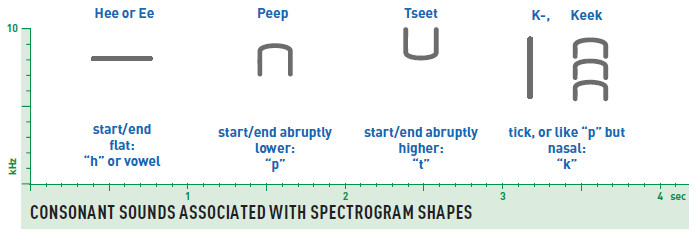The naming of bird sounds
(Peterson Field Guide to Bird Sounds, interactive version of pp. 24-25)
Traditionally, bird sounds have been named either for their biological function (“alarm call,” “flight call,” “begging call,” “song”) or for their sound (“chewink,” “chip,” “buzz,” “rattle”).
Naming sounds for their function is often difficult, because little is known about the functions of many bird sounds. Even more important, one sound frequently serves several different functions, and different sounds can serve the same function. But assigning names based on sound can also be difficult, especially for sounds that are complex, highly variable, or plastic (see p. 28).
No method of naming sounds is perfect. This book seeks to strike a balance by using the name “Song” for primary breeding-season vocalizations that likely serve in mate attraction and territorial defense, and using sound-based names in most other cases. Mnemonic phrases are listed for some songs, when they are deemed useful.
In this book, the names of vocalizations are capitalized.
Transcribing bird sounds into human speech
One way to describe bird sounds is by transcribing them into the English alphabet. Bird voices and human voices are vastly different, and no standard method of transcription exists, but people do tend to follow certain patterns when imitating bird sounds in speech.
Vertical = consonant; horizontal = vowel
On the spectrogram, many bird sounds start and end with brief steep sections. The shape of the steep part tends to determine the consonant sound that many people hear, as follows:
Listeners do not always agree on consonants, especially at the end of a sound. There tends to be more agreement on vowels.
Certain consonants correspond to tone qualities
In addition to the consonants that correspond to spectrogram shapes, some consonants are often used to indicate the quality of a sound, as follows:
| consonant | often denotes a sound that is |
| s | very high-pitched |
| ch, sh | noisy |
| r | burry (but see below) |
| z | buzzy or polyphonic |
| l | broken |
Different vowels represent different pitches
Linguists describe vowels as “high” or “low” based on the height of the tongue in the mouth during pronunciation. Low-pitched bird sounds are often transcribed using low vowels, and high-pitched bird sounds are often transcribed using high vowels.
The letters r, w, and y are vowel-like consonants (or “semivowels”) that also correspond to pitches: r and w are low, while y is high.
Vowel combinations represent changes in pitch
Monotone bird sounds are typically written with a single vowel sound. Bird sounds that change in pitch are typically written with a combination of vowels and semivowels that mirrors the change in pitch. For example, upslurred sounds are usually transcribed with a low vowel or semivowel, followed immediately by a higher one.


